
Film stock is an analog medium that is used for recording motion pictures or animation. It is recorded on by a movie camera, developed, edited, and projected onto a screen using a movie projector. It is a strip or sheet of transparent plastic film base coated on one side with a gelatin emulsion containing microscopically small light-sensitive silver halide crystals. The sizes and other characteristics of the crystals determine the sensitivity, contrast and resolution of the film. The emulsion will gradually darken if left exposed to light, but the process is too slow and incomplete to be of any practical use. Instead, a very short exposure to the image formed by a camera lens is used to produce only a very slight chemical change, proportional to the amount of light absorbed by each crystal. This creates an invisible latent image in the emulsion, which can be chemically developed into a visible photograph. In addition to visible light, all films are sensitive to X-rays and high-energy particles. Most are at least slightly sensitive to invisible ultraviolet (UV) light. Some special-purpose films are sensitive into the infrared (IR) region of the spectrum.
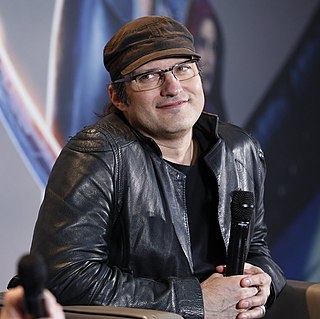
Robert Anthony Rodriguez is an American filmmaker and visual effects supervisor. He shoots, edits, produces, and scores many of his films in Mexico and in his home state of Texas. Rodriguez directed the 1992 action film El Mariachi, which was a commercial success after grossing $2.6 million against a budget of $7,000. The film spawned two sequels known collectively as the Mexico Trilogy: Desperado and Once Upon a Time in Mexico.

Widescreen images are images that are displayed within a set of aspect ratios used in film, television and computer screens. In film, a widescreen film is any film image with a width-to-height aspect ratio greater than the standard 1.37:1 Academy aspect ratio provided by 35 mm film.
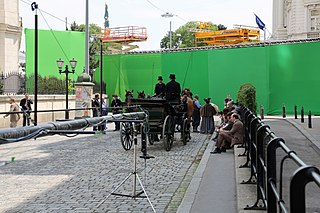
Special effects are illusions or visual tricks used in the theatre, film, television, video game, and simulator industries to simulate the imagined events in a story or virtual world.
A movie camera, film camera or cine-camera is a type of photographic camera which takes a rapid sequence of photographs on an image sensor or on a film. In contrast to a still camera, which captures a single snapshot at a time, the movie camera takes a series of images; each image constitutes a "frame". This is accomplished through an intermittent mechanism. The frames are later played back in a movie projector at a specific speed, called the frame rate. While viewing at a particular frame rate, a person's eyes and brain merge the separate pictures to create the illusion of motion.
Visual effects is the process by which imagery is created or manipulated outside the context of a live action shot in filmmaking and video production. The integration of live action footage and other live action footage or CG elements to create realistic imagery is called VFX.

Casshern is a 2004 Japanese tokusatsu superhero film adaptation of the anime series of the same name. It was written and directed by Kazuaki Kiriya.
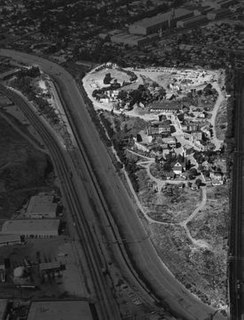
A backlot is an area behind or adjoining a movie studio containing permanent exterior buildings for outdoor scenes in filmmaking or television productions, or space for temporary set construction.

Compositing is the process or technique of combining visual elements from separate sources into single images, often to create the illusion that all those elements are parts of the same scene. Live-action shooting for compositing is variously called "chroma key", "blue screen", "green screen" and other names. Today, most, though not all, compositing is achieved through digital image manipulation. Pre-digital compositing techniques, however, go back as far as the trick films of Georges Méliès in the late 19th century, and some are still in use.
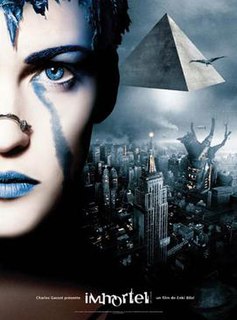
Immortal is a 2004 English language French live-action and animated science fiction film co-written and directed by Enki Bilal and starring Linda Hardy, Thomas Kretschmann and Charlotte Rampling. It is loosely based upon Bilal's comic book La Foire aux immortels.

CineAlta cameras are a series of professional digital movie cameras produced by Sony that replicate many of the same features of 35mm film motion picture cameras.

Digital cinematography is the process of capturing (recording) a motion picture using digital image sensors rather than through film stock. As digital technology has improved in recent years, this practice has become dominant. Since the mid-2010s, most movies across the world are captured as well as distributed digitally.

The Genesis is Panavision's high-end digital movie camera, which uses a proprietary, full frame 35 mm-width, 1.78:1 (16:9) aspect ratio, 12.4-megapixel, RGB filtered CCD. It was first used by a feature crew to shoot Bryan Singer's Superman Returns and was shortly followed up thereafter by the World War I film Flyboys. However, the CG-heavy nature of these two movies meant that ultimately the comedy Scary Movie 4 was the first theatrically released feature sourced primarily from the Genesis camera.

Virtual cinematography is the set of cinematographic techniques performed in a computer graphics environment. It includes a wide variety of subjects like photographing real objects, often with stereo or multi-camera setup, for the purpose of recreating them as three-dimensional objects and algorithms for the automated creation of real and simulated camera angles. Virtual cinematography can be used to shoot scenes from otherwise impossible camera angles, create the photography of animated films, and manipulate the appearance of computer-generated effects.
Digital 3D is a non-specific 3D standard in which films, television shows, and video games are presented and shot in digital 3D technology or later processed in digital post-production to add a 3D effect.
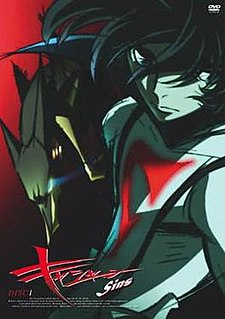
Casshern Sins is a reboot of the 1973 anime series Casshan, produced by Tatsunoko Productions and animated by Madhouse. The series discards the continuity presented in the original Casshan anime series, in which Casshern was a cybernetic superhero battling the evil robotic forces of Braiking Boss in a post-apocalyptic Earth. In Casshern Sins, Casshern is presented as a cyborg subordinate of Braiking Boss who was ordered to assassinate the savior of mankind, and has thus doomed the Earth to ruin. Casshern Sins made its English broadcast premiere on Funimation Channel on December 14, 2010. A manga adaptation was published in Jive's Comic Rush Magazine. In the United States, the series began airing on Adult Swim's revived Toonami programming block as part of its relaunch on May 27, 2012.
A film studio is a major entertainment company or motion picture company that has its own privately owned studio facility or facilities that are used to make films, which is handled by the production company. Most firms in the entertainment industry have never owned their own studios, but have rented space from other companies.
Articles related to the field of motion pictures include:

The Arri Alexa is a digital motion picture camera system developed by Arri. First introduced in April 2010, the camera was Arri's first major transition into digital cinematography after smaller previous efforts such as the Arriflex D-20 and D-21.

Computer-generated imagery (CGI) is the application of computer graphics to create or contribute to images in art, printed media, video games, simulators, computer animation and VFX in films, television programs, shorts, commercials, and videos. The images may be dynamic or static, and may be two-dimensional (2D), although the term "CGI" is most commonly used to refer to the 3-D computer graphics used for creating characters, scenes and special effects in films and television, which is described as 'CGI animation'. It was first used in the 1986 film Flight of the Navigator, although an earlier, more crude version of CGI was featured in the 1984 film, The Last Starfighter.












